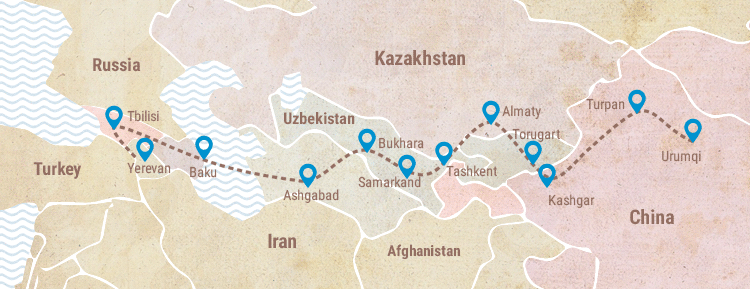
The Silk Road originated in Chang’an, the ancient capital of China, and went along the northern Tien-Shan to Dunhua, the city near the Great Wall of China. There the single road split bordering the Taklamakan desert from the north and the south. The northern way went through Turfan to the Ili river valley. The Middle road (the so-called Southern way) led from Zhang Qian to the southern coast of Lake Issyk Kul- via Khotan and Yarkand, and reached Bactria (northern Afghanistan). There the Southern route split in two other roads: one followed to India, the other to the West and Merv where it merged with the Northern route. Further it passed via Nisa, the capital Parthia, Iran, Mesopotamia, Bagdad, went to Damascus and reached the Mediterranean.
And finally, the third, the most difficult was called the Northern or the Steppe route. Having crossed the Tien Shan a part of caravans went via Fergana valley and Tashkent oasis to Samarkand, Bukhara, Khoresm and reached the coast of the Caspian Sea. A part of caravans from Samarkand headed to Bactria and after crossing the Kashkadarya valley led to Termez. Then caravans forded the Amu Darya and went to the Middle East and India.
Beside the three main lines of the Silk Road there were also other roads by means of which all those three lines were interconnected.
The sea part of the Silk Road started in Alexandria and in Egypt, went across the Red Sea and the Indian Ocean to the ports of the western coast of India. From there that route followed to Bactria, to the city of Termez. And then it followed on the Amu Darya to Khoresm and the Caspian Sea. Then it crossed the territory of Albania (Azerbaijan), Iberia and Colchis (Georgia), reached the Black Sea and went further to Rome. It was the shortest way from India to the countries of Transcaucasia.
The Caucasian Silk Road started in ancient Samarkand. It went to Khoresm, followed around the Caspian Sea, crossed the steppes of North Caucasus, and then went down to the city of Tskhum. From there trade caravans crossed the Black Sea to reach Constantinople, the capital of Byzantium.
The important road went from the Bottom Volga region along the western coast of the Caspian Sea through the Caspian Iron Gate, the city of Derbent, to the south, to ancient Albania and Parthia connecting the northern and main routes of the Silk Road.
With time the routes underwent changes as it was required by political situations. So, in the 4th -8th centuries the main route included Syria - Iran - Central Asia - Southern Kazakhstan - the Talas valley - the Chuya valley - the Issyk-Kul hollow - East Turkestan. The branch of that route, more precisely, another route went to the line from Byzantium via Derbent to the Near-Caspian steppes - Mangyshlak – Near-Aral - Southern Kazakhstan. That can be explained by the fact that Turkic khagans started to control the trade there.
So, the sector crossing Central Asia became especially busy. Rich cities, merchants and craftsmen settlements, caravanserais started to appear and prosper. In Turkmenia it was Merv; in Uzbekistan — Bukhara, Samarkand, Urgench, Khiva; in Kazakhstan — Otrar, Turkestan, Taraz, Ispedzhab; in Kirghizia — Dzhul, Suyab, Novokents, Balasagyn, Barskoon, Tash-Rabat, Osh, Uzgen. Today they form the necklace along which main tourist routes around Central Asia pass.
Not so long ago the countries-participants of the Silk Road such as China, Kirghizia, Kazakhstan, Uzbekistan and others, have decided to jointly apply for UNESCO in order to designate the Silk Road as World Heritage Site.

